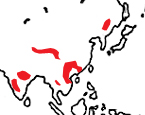|
Tiger
(Panthera tigris) |
||||
|
| Physical
characteristics and distribution |
|
Tiger
Panthera tigris P.
tigris is found in a variety of habitats
throughout its region, requiring adequate
shelter, water and prey. Tropical rainforests,
evergreen forests, mangrove swamps, grasslands,
savannahs, and rocky terrain can all provide
these necessities for this carnivore. A
good swimmer, P. tigris has been
known to swim distances of 29 km. Although
it prefers not to climb trees it is extremely
capable of doing so and can make a vertical
leap of up to 10 m. Two or three favorite
dens are usually within the animal's territory,
in hollow trees, caves or dense vegetation. The Indian Subcontinent is home to more than 80% of the wild tigers in the world. Due to its many clashes with humans, many of which are fatal, P. tigris has been hunted and trapped to an extent which has it listed as endangered by the IUCN and the USDI and it is on appendix 1 of the CITES. It is now found in Bangladesh, Bhutan, Cambodia, China, India, Indonesia (Sumatra only), Laos, Malaysia, Burma, Nepal, Russia, Thailand and Vietnam. |
|
Description
of the brain
|
|
Animal
source and preparation
|
|
All
specimens collected followed the same preparation
and histological procedure.
|
Other Related Resources (websites and publications)



